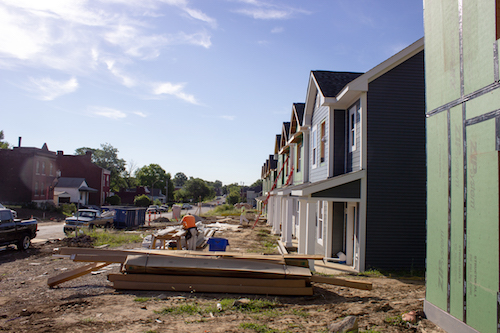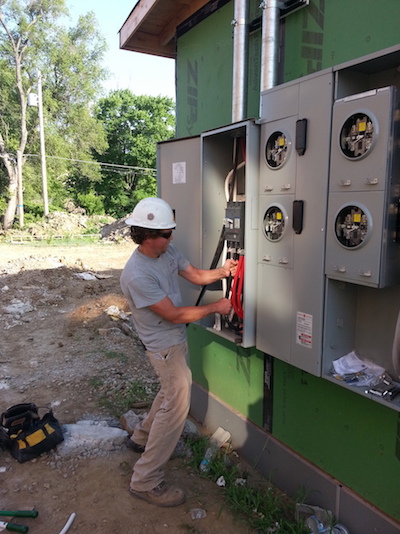The Ville neighborhood on St. Louis’s near north side is an historic one for the region and the IBEW.
It was a middle-class enclave for the city’s black residents for part of the 20th century while much of the city struggled with segregation. Important American cultural figures raised there include rock musician Chuck Berry, singer Josephine Baker and comedian and social activist Dick Gregory. Tennis star and human rights activist Arthur Ashe spent part of his teenage years there.

|
More than 30 new housing units are part of St. Ferdinand II, which is designed to bring affordable housing to an area that has seen little investment during the last 50 years.
Photo provided by Brandon Moncanda.
|
In the adjoining JeffVanderLou neighborhood is the Henry Miller Museum, a renovated boarding house where Miller and nine other founding delegates convened the first meeting of the National Brotherhood of Electrical Workers in 1891.
So, it’s only fitting that St. Louis Local 1 and its signatory contractors are working alongside community organizations to bring affordable housing to The Ville with construction of the St. Ferdinand II project. The 36 new and seven renovated apartments – officially called St. Ferdinand Homes II-- will occupy the space where 13 dilapidated buildings once stood.
New construction in the area, which has struggled for more than 50 years, has been virtually non existent while community assets such as a local public hospital have closed.
“There hasn’t been much built over there in quite some time,” said Local 1 business agent Mike Newton, who grew up on the city’s north side. “These were the first really new construction projects in that area in a while. On the residential side, it’s pretty high profile.”
The project is a 12-building apartment complex designed to provide quality housing in an area that has been lacking it for decades. It’s being funded by the Missouri Housing Development Commission, a publicly funded state agency, along with the locally based St. Louis Equity Fund and Gateway Community Development Fund.
Local 1 members have taken a prominent role among the hundreds of tradesmen and women on site. Signatory American Electric & Data, which is owned and operated by member Tom Prade, is one of the lead contractors.
But much of the work has spread to smaller signatory contractors as well. One sub contractor working under American Electric is J West. It is owned by Sabrina Westfall, who completed a Local 1 apprenticeship and was a member until she started her company in 2009.
Westfall said collaborating with Local 1 and the Electrical Connection – the St. Louis chapter of the National Electrical Contractors Association – was perfect for a company like J West. With her union background, she knew she would always have a pool of skilled workers available quickly when she lands a project.
“When I started talking to both the IBEW and NECA to see what I was getting into, I knew I could rely on a team that works,” said Westfall, who had as many as 14 employees at times during 2018. “Just having trained electricians I knew I could rely on meant a lot for a small business like mine.”

|
Collinsville, Ill., Local 309 member Lou Baczweski terminates 350 for a multipack service at the new housing project.
Photo provided by Brandon Moncanda.
|
That came in handy when bidding work on St. Ferdinand II, which follows a smaller complex nearby also named St. Ferdinand.
“This is a major project,” said Michael Burns, president of Northside Community Housing, which works to provide quality housing for low- and middle-income residents and is the St. Ferdinand project developer. “We see ourselves helping to connect the Delmar Divide here in St. Louis.”
The divide is a 9-mile stretch of Delmar Boulevard that separates the overwhelmingly black north side with the majority-white south side. The divide took on international significance when it was featured in a 2012 documentary by the BBC and was often referenced during the racially-charged riots in nearby Ferguson, Mo., two years later.
South of Delmar has seen significant investment in recent years, evidenced by rising incomes and home values. North of Delmar neighborhoods such as The Ville – in which 97 percent of the residents are black – have seen little of that.
Now, things may be changing.
“One of the cool things about St. Ferdinand is that a lot of people had the sense the city at large was giving up on The Ville,” said Jessica Eiland, a project manager for Rise St. Louis, which works to connect key groups looking to revitalize the city’s neighborhoods. “To see that investment from the state level down to the local level means a lot. The people who live there see that as a huge project.”
Eiland also credits the IBEW and NECA for hiring qualified minority contractors for a project in a largely minority area, such as Westfall, who is black.
“It means a lot to have people come out and see sub contractors working on the job that actually look like them,” she said.
Although not directly related to the housing project, the federal government’s National Geospatial-Intelligence Agency is building a new facility on 97 acres less than two miles from The Ville. It is the largest federal investment project in St. Louis history and is expected to spur more development.
Westfall envisions more construction coming to The Ville and other northside neighborhoods and she wants her company to be a part of it.
“It’s something that is necessary,” she said. “People in that community and north St. Louis have wanted to see change and progression. Having that [geospatial facility] is definitely helping it.”
Added Newton: “Just to see anything new being built on the north side is good news. … Especially when you know it’s union.”
Business Manager Frank Jacobs said Local 1 and its members built several good relationships in the area during the renovation of the Henry Miller Museum, which culminated with its official opening during the 2016 International Convention in St. Louis. That should help it and its signatory contractors land work as the neighborhoods continue to develop.
“We’re proud to play a small part in bringing that community back,” Jacobs said. “The more the city of St. Louis thrives, the better it is for us and our allies in the labor community. Providing work for our members while also providing for neighborhoods in need is what the IBEW has been doing for more than 100 years. We plan to continue that.”